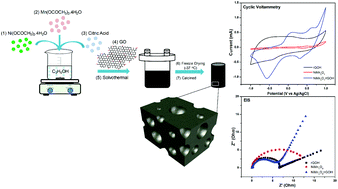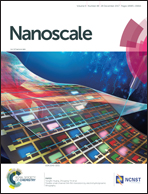NiMn2O4 spinel binary nanostructure decorated on three-dimensional reduced graphene oxide hydrogel for bifunctional materials in non-enzymatic glucose sensor†
Abstract
Nickel–manganese spinel oxide (NiMn2O4) was hybridized with reduced graphene oxide hydrogel (rGOH) via a facile solvothermal process and a highly porous three-dimensional (3D) structure was constructed. NiMn2O4/rGOH exhibited excellent electrochemical performance due to the high specific surface area, excellent electrocatalytic activity, and enhanced electrical conductivity due to the synergetic effects between the two components. The NiMn2O4/rGOH exhibited excellent glucose sensing performance with high sensitivity (1310.8 μA mM−1 cm−2), a wide linear range (2 μM–20 mM), rapid response time (<3.5 s), and anti-interference properties. Furthermore, it also showed excellent supercapacitor performance with a high capacitance (396.85 F g−1) and excellent energy and power density on account of the large surface area and pseudo-capacitor behavior of NiMn2O4. A self-powered glucose sensor can be fabricated with NiMn2O4/rGOH as both supercapacitor and glucose sensing electrodes.



 Please wait while we load your content...
Please wait while we load your content...